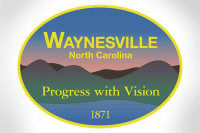Under the Bright Lights: Smoky Mountain Community Theatre
It’s the heartbeat of a town.
Coming into its 37th year, the Smoky Mountain Community Theatre has become a beacon of culture, education and creativity within Bryson City.
‘In the Soundless Awe’: Play co-written by Western Carolina University professor
The haunting final moments of the man at the helm of the worse naval disaster in U.S. history will be portrayed as Western Carolina University’s School of Stage and Screen presents “In the Soundless Awe,” a play co-written by Jayme McGhan, associate professor and director of the school.
The production, part of WCU’s Mainstage theater season, will be staged at Hoey Auditorium at 7:30 p.m. Wednesday, Nov. 16 through Saturday, Nov. 19, and at 3 p.m. Sunday, Nov. 20.
New stage to open next month
 Sitting on a bench one recent sunny afternoon, Steven Lloyd gazes to his right, a big smile immediately rolling across his face.
Sitting on a bench one recent sunny afternoon, Steven Lloyd gazes to his right, a big smile immediately rolling across his face.
“When I look over there, I see potential — a lot of potential,” he said.
Onstage at WCU
 Galaxy of Stars offers a variety of entertainment
Galaxy of Stars offers a variety of entertainment
A tribute to a comedic icon, a holiday show featuring the “Redneck Tenors” and a performance by an American country-pop superstar top the lineup for the 2015-16 Galaxy of Stars Series at Western Carolina University.
When a vision comes to life: Filmed in Haywood, ‘Chasing Grace’ hits the big screen
 I was a little apprehensive.
I was a little apprehensive.
Strolling into The Strand at 38 Main this past Friday evening, the buzz around downtown Waynesville was the premiere of “Chasing Grace.” A faith-based thriller, the film was shot in town and around Haywood County. But, how would it fare on the silver screen?
‘The Rocky Horror Picture Show’ to hit WCU stage
 Transvestite. Transsexual. Transylvania.
Transvestite. Transsexual. Transylvania.
Three words that immediately conjure images of extravagant parties, mad scientists, death, rock-n-roll, Meatloaf, aliens, sing-a-longs, freedom and sexual liberation. What “The Rocky Horror Picture Show” did, and continues to do, for society can never be overstated. Originally written as a stage musical, the story hit the big screen in 1975, cueing a new dawn in acceptance and understanding in everyday life. It kicked the door down for punk rock, 20th century cultural evolution, independent filmmaking and LGBT rights by simply stepping over the line of what it means to truly be yourself in a sometimes stifling world where being one-in-the-same is “easier” than being one-in-a-million.
The heartbeat of a community
 It never ceases to amaze Lorraine Conard.
It never ceases to amaze Lorraine Conard.
“It’s a little bit magical,” she said. “You walk in and there’s this energy and excitement, a heartbeat within the community — I’m always so grateful and thankful for the people who come in.”
Sitting in the front room of The Strand at 38 Main in downtown Waynesville, Lorraine and her husband Rodney are the owners of the movie theatre. A beloved destination for many years within the town, it lay dormant for far too long, only to be purchased, renovated and revived by the young couple.
On with the show
 Though the process has been long, Steven Lloyd is beginning to see the fruits of his labor.
Though the process has been long, Steven Lloyd is beginning to see the fruits of his labor.
“I sometimes feel like I’ve pushed a big boulder up a hill and it’ll fall backwards,” he said. “But, the momentum is still going. We’re a proven, successful theatre, and this is going to happen.”
The big screen comes to a small town
By Colby Dunn • Correspondent
For residents of Highlands, the list of things to do in town, depending on the season, can be pretty short and “go to the movies” has never been on it. But the town is filmless no more, thanks to a new program at the Highlands Playhouse that’s bringing in the blockbusters four nights a week.
Cherokee theater expands to six screens
 When Cherokee Phoenix Theatres on the Qualla Boundary closes on All Hallows’ Eve, it will only have two movie screens. When it reopens the following morning, as if by some magic, the number of screens will have multiplied.
When Cherokee Phoenix Theatres on the Qualla Boundary closes on All Hallows’ Eve, it will only have two movie screens. When it reopens the following morning, as if by some magic, the number of screens will have multiplied.





